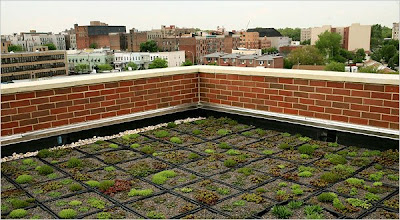"Greening the Ghetto"
In the New York Times today, this profile of Intervale Green on Intervale Avenue between Freeman Street and Louis Niñe Boulevard, "an infamous strip of South Bronx urban blight (it served as backdrop for some of the most gruesome scenes in the movie “Fort Apache, the Bronx”)," was yet another reminder that the Bronx is on the cutting edge of the green movement and the environmental justice movement: "A Green Building, for Those Without Much of the Green Stuff to Spare".

"The South Bronx was once known exclusively for its burned-down buildings, drug wars and piles of rubble. When historians look back at the current era in the borough, they’ll still see intractable crime and poverty, but they’ll also see, out of the nonprofit group Sustainable South Bronx, an early program to train unskilled workers in green careers, which may prove to be a model nationwide for stimulus-funded green job-training programs. They’ll also see Intervale Green, which Ms. Biberman says is currently the largest affordable green housing development in the country."
A little while ago, an article in the Boston Globe summarized a few different research projects that showed that proximity to green space and well designed parks can counteract some of the negative effects of urban life caused by crowding and overstimulation, thereby improving mental health, emotional self control, and cognitive functioning and ultimately reducing crime and improving resiliency and ability to cope with major life challenges: "How The City Hurts Your Brain".
"[S]cientists have begun to examine how the city affects the brain, and the results are chastening. Just being in an urban environment, they have found, impairs our basic mental processes. After spending a few minutes on a crowded city street, the brain is less able to hold things in memory, and suffers from reduced self-control.
"[Researchers] measured the two groups on a variety of tasks, from basic tests of attention to surveys that looked at how the women were handling major life challenges. [They] found that living in an apartment with a view of greenery led to significant improvements in every category."
"City life can also lead to loss of emotional control. [Researchers] found less domestic violence in the apartments with views of greenery. These data build on earlier work that demonstrated how aspects of the urban environment, such as crowding and unpredictable noise, can also lead to increased levels of aggression. A tired brain, run down by the stimuli of city life, is more likely to lose its temper."

"The South Bronx was once known exclusively for its burned-down buildings, drug wars and piles of rubble. When historians look back at the current era in the borough, they’ll still see intractable crime and poverty, but they’ll also see, out of the nonprofit group Sustainable South Bronx, an early program to train unskilled workers in green careers, which may prove to be a model nationwide for stimulus-funded green job-training programs. They’ll also see Intervale Green, which Ms. Biberman says is currently the largest affordable green housing development in the country."
A little while ago, an article in the Boston Globe summarized a few different research projects that showed that proximity to green space and well designed parks can counteract some of the negative effects of urban life caused by crowding and overstimulation, thereby improving mental health, emotional self control, and cognitive functioning and ultimately reducing crime and improving resiliency and ability to cope with major life challenges: "How The City Hurts Your Brain".
"[S]cientists have begun to examine how the city affects the brain, and the results are chastening. Just being in an urban environment, they have found, impairs our basic mental processes. After spending a few minutes on a crowded city street, the brain is less able to hold things in memory, and suffers from reduced self-control.
"[Researchers] measured the two groups on a variety of tasks, from basic tests of attention to surveys that looked at how the women were handling major life challenges. [They] found that living in an apartment with a view of greenery led to significant improvements in every category."
"City life can also lead to loss of emotional control. [Researchers] found less domestic violence in the apartments with views of greenery. These data build on earlier work that demonstrated how aspects of the urban environment, such as crowding and unpredictable noise, can also lead to increased levels of aggression. A tired brain, run down by the stimuli of city life, is more likely to lose its temper."
Comments